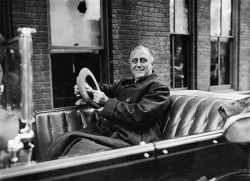Click here for General Background
President Franklin D. Roosevelt and Polio
“Once you’ve spent two years trying to wiggle one toe, everything is in proportion.” ~ Franklin D. Roosevelt, 1945

Roosevelt never walked again after polio
and used a special car to get around
(Roosevelt Library)
and used a special car to get around
(Roosevelt Library)
"In 1921, at the age of 39—old for a polio victim—the normally vigorous Roosevelt fell ill when vacationing at his family's summer home at Campobello Island in Canada. At first, he had aches and pains, weakness in his legs, and a fever of 102 degrees. His doctor could tell immediately that FDR had polio.
Roosevelt, who planned a life in politics, wouldn't accept the limitations of his disease. But how could he demonstrate that he was healthy and strong enough to run for office? Although Roosevelt made no secret of the disease—the New York Times carried the story of his illness on the front page—he downplayed the severity of his disability. The public rarely saw him sitting in a wheelchair or using the steel braces he needed to walk. By common, unspoken consent, the press almost never photographed Roosevelt while he was in motion.
In addition to giving speeches, Roosevelt took concrete actions to help the cause of polio. In 1924, he had discovered the healing waters of a resort in Warm Springs, Georgia, and went there regularly for swimming and other vigorous exercise to strengthen his muscles. Two years later, he bought the resort for $200,000, a good portion of his personal wealth, and, in 1927, formed the Georgia Warm Springs Foundation, a hydrotherapy center for polio victims. FDR sometimes even led physical therapy sessions with patients, who called him "Uncle Rosey." Many of the treatment techniques for patients recovering from polio and other paralytic disorders, as well as orthopedic designs and principles, were developed at Warm Springs. For example, the hand controls that allowed FDR to drive a car originated at Warm Springs, which is now the Roosevelt Institute for Rehabilitation".
~ Howard Hughes Medical Institute
Roosevelt, who planned a life in politics, wouldn't accept the limitations of his disease. But how could he demonstrate that he was healthy and strong enough to run for office? Although Roosevelt made no secret of the disease—the New York Times carried the story of his illness on the front page—he downplayed the severity of his disability. The public rarely saw him sitting in a wheelchair or using the steel braces he needed to walk. By common, unspoken consent, the press almost never photographed Roosevelt while he was in motion.
In addition to giving speeches, Roosevelt took concrete actions to help the cause of polio. In 1924, he had discovered the healing waters of a resort in Warm Springs, Georgia, and went there regularly for swimming and other vigorous exercise to strengthen his muscles. Two years later, he bought the resort for $200,000, a good portion of his personal wealth, and, in 1927, formed the Georgia Warm Springs Foundation, a hydrotherapy center for polio victims. FDR sometimes even led physical therapy sessions with patients, who called him "Uncle Rosey." Many of the treatment techniques for patients recovering from polio and other paralytic disorders, as well as orthopedic designs and principles, were developed at Warm Springs. For example, the hand controls that allowed FDR to drive a car originated at Warm Springs, which is now the Roosevelt Institute for Rehabilitation".
~ Howard Hughes Medical Institute

Franklin Roosevelt
(historycentral.com)
(historycentral.com)
“For a generation, Warm Springs was a community of the handicapped. A permanent
population of polios came to live at the Foundation or nearby. Many of these people
worked at the Foundation as officials, staff people, and teachers. New polios saw the
old polios as persons with a paralysis pattern similar to their own, living a normal life,
functioning as productive human beings. The value of such an example was enormous.”
~ Hugh G. Gallagher, 1998
In 1937 President Roosevelt established the National Foundation for Infantile Paralysis or March of Dimes. He and the March of Dimes were so closely associated that Congress honored his memory by putting his face on the dime.
Roosevelt did not live to see the vaccine.
Roosevelt did not live to see the vaccine.